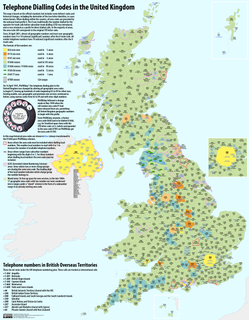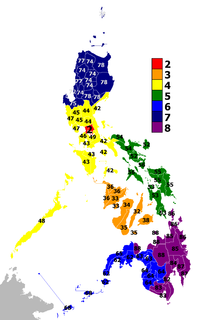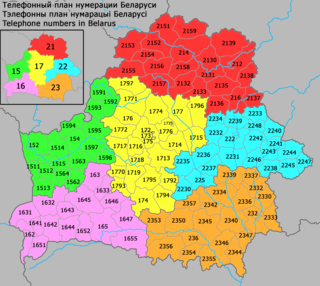Related Research Articles
In statistics, survey sampling describes the process of selecting a sample of elements from a target population to conduct a survey. The term "survey" may refer to many different types or techniques of observation. In survey sampling it most often involves a questionnaire used to measure the characteristics and/or attitudes of people. Different ways of contacting members of a sample once they have been selected is the subject of survey data collection. The purpose of sampling is to reduce the cost and/or the amount of work that it would take to survey the entire target population. A survey that measures the entire target population is called a census. A sample refers to a group or section of a population from which information is to be obtained
The North American Numbering Plan (NANP) is a telephone numbering plan for World Zone 1, which comprises twenty-five distinct regions in twenty countries primarily in North America, including the Caribbean. Some North American countries, most notably Mexico, do not participate in the NANP.
A telephone numbering plan is a type of numbering scheme used in telecommunication to assign telephone numbers to subscriber telephones or other telephony endpoints. Telephone numbers are the addresses of participants in a telephone network, reachable by a system of destination code routing. Telephone numbering plans are defined in each of the administrative regions of the public switched telephone network (PSTN) and in private telephone networks.

Telephone numbers in the United Kingdom are administered by the Office of Communications (Ofcom). For this purpose, Ofcom established a telephone numbering plan, known as the National Telephone Numbering Plan, which is the system for assigning telephone numbers to subscriber stations.

The Australian telephone numbering plan describes the allocation of phone numbers in Australia. It has changed many times, the most recent major reorganisation by the Australian Communications and Media Authority taking place between 1994 and 1998.

The French telephone numbering plan is not only used for metropolitan France but also for the French overseas departments and some overseas collectivities.
Ten-digit dialing is a telephone dialing procedure in the countries and territories that are members of the North American Numbering Plan (NANP). It is the practice of including the area code of a telephone number when dialing to initiate a telephone call. When necessary, the ten-digit number may be prefixed with the trunk code 1, which is referred to as 1+10-digit dialing or national format.
Seven-digit dialing is a telephone dialing procedure customary in the territories of the North American Numbering Plan, for dialing telephone numbers in the local calling area. The procedure is also sometimes known as local format or network format.
Number pooling is a method of reallocating telephony numbering space in the North American Numbering Plan, primarily in growth areas in the United States.
The Brazilian telephone numbering plan uses a two-digit area code plus eight-digit local phone numbers for landlines and nine digits for mobile lines. Public utility services use short phone numbers, always starting with 1.

Telephone numbers in Turkey went from six (2+4) to seven digits (3+4) local phone numbers c.1988, at which time Ankara went from 41 to 4. There used to be more than 5,000 local area codes of varying lengths with correspondingly varying local number lengths.
A feature group, in North American telephone industry jargon, is most commonly used to designate various standard means of access by callers to competitive long-distance services. They defined switching arrangements from local exchange carriers central offices to interexchange carriers. These arrangements were described in an official tariff of the National Exchange Carrier Association, filed with the Federal Communications Commission (FCC).

Gallup, Inc. is an American analytics and advisory company based in Washington, D.C. Founded by George Gallup in 1935, the company became known for its public opinion polls conducted worldwide. Starting in the 1980s, Gallup transitioned its business to focus on providing analytics and management consulting to organizations globally. In addition to its analytics, management consulting, and Gallup Poll, the company also offers educational consulting, the CliftonStrengths assessment and associated products, and business and management books published by its Gallup Press unit.
Automated telephone surveys is a systematic collection a data from demography by making calls automatically to the preset list of respondents at the aim of collecting information and gain feedback via the telephone and the internet. Automated surveys are used for customer research purposes by call centres for customer relationship management and performance management purposes. They are also used for political polling, market research and job satisfaction surveying.

Telephone numbers in the Philippines follow an open telephone numbering plan and an open dial plan. Both plans are regulated by the National Telecommunications Commission, an attached agency under the Department of Information and Communications Technology (DICT).
The following telephone numbers in Kenya are destination codes for international calls terminating in Kenya as well as the procedures for dialling internationally from within Kenya. Until 1999, Kenya shared its telephone numbering plan with Tanzania and Uganda, meaning that to make calls between the three countries, subscribers needed only dial the area code and number, a legacy of the East African Post and Telecommunications Corporation (EAPTC) which was dissolved in 1977. As a result of the reorganisation of Tanzania's numbering plan in that year, direct dialling was discontinued, although calls between the three countries do not require international dialling, only a special three-digit code.
The national conventions for writing telephone numbers vary by country. While international standards exist in the form of the International Telecommunication Union sector ITU-T issued recommendation E.123, national telephone numbering plans define the format and length of telephone numbers assigned to telephones.

A telephone number is a sequence of digits assigned to a fixed-line telephone subscriber station connected to a telephone line or to a wireless electronic telephony device, such as a radio telephone or a mobile telephone, or to other devices for data transmission via the public switched telephone network (PSTN) or other public and private networks.
The Health Information National Trends Survey (HINTS) is a cross-sectional, nationally representative survey of American adults sponsored by the National Cancer Institute. HINTS provides publicly available data on American adults' knowledge of, attitudes toward, and behaviors related to cancer prevention, control and communication. Researchers use the data to identify trends in health communication, including how people find cancer information, which sources they use, their feelings about the search process, and how they perceive cancer overall.

Belarus began using its own country code +375 in 1995, replacing the +7 international country code inherited from the Soviet Union. The local numbering plan was inherited from the Soviet Union and remains with few changes.
References
- ↑ Donald P. Green; Alan S. Gerber (2002-05-05). "Enough Already with Random Digit Dialing: A Proposal to Use Registration-Based Sampling to Improve Pre-Election Polling" (PDF).Cite journal requires
|journal=(help) - ↑ Sara H. Olson; Jennifer L. Kelsey; et al. (1992-01-15). "Evaluation of Random Digit Dialing as a Method of Control Selection in Case–Control Studies". Archived from the original on 2007-03-22.Cite journal requires
|journal=(help)